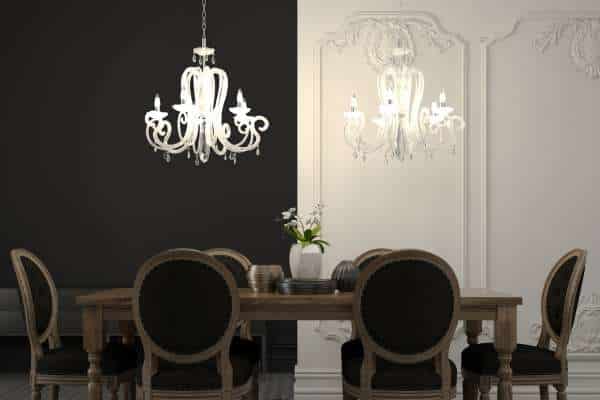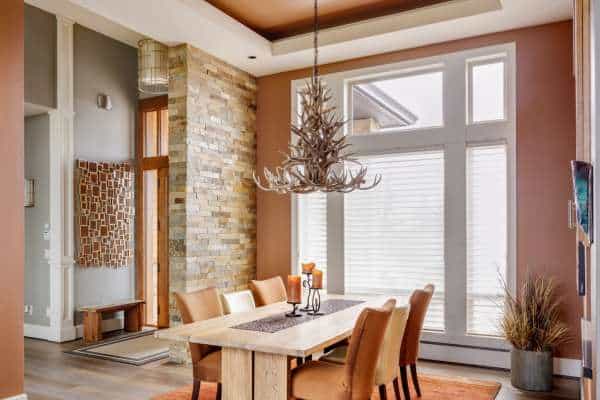Hanging a chandelier over a dining table is a key design decision that can significantly impact the ambiance and functionality of your dining space. The right height not only enhances the room’s aesthetics but also ensures comfortable lighting for dining and conversation. Whether you’re aiming for a cozy, intimate setting or a grand, elegant atmosphere, finding the perfect height for your chandelier is essential. In this guide, we’ll explore the best practices and factors to consider when determining how high to hang a chandelier over your dining table, helping you create a balanced and visually appealing dining area.
1. Standard Height Guidelines
The standard guideline for hanging a chandelier over a dining table is to position it 30 to 36 inches above the table surface. This height typically provides the best balance between illumination and aesthetics, ensuring the chandelier is neither too low nor too high. However, several factors can influence the ideal height, such as the ceiling height, chandelier size, and dimensions of the dining table. For instance, in rooms with higher ceilings, you may need to adjust the chandelier higher to maintain proper proportions. Similarly, a larger chandelier may require slightly more space to avoid overwhelming the table.
2. Calculating the Right Height

Calculating the right height for hanging a chandelier over your dining table involves a few simple steps to ensure the perfect placement. Start by measuring 30 to 36 inches from the table surface, which is the standard height for most settings. Next, consider the size of the chandelier relative to the table and room; a larger chandelier might need to hang slightly higher to maintain balance, while a smaller one can be positioned closer to the table. For rooms with 8-foot ceilings, sticking to the standard height works well, but if you have taller ceilings, raise the chandelier by 3 inches for every additional foot of ceiling height.
3. Factors to Consider
The size of your dining table plays a crucial role; for instance, round or square tables may require a different chandelier placement than a rectangular one to maintain balance and symmetry. Room size and ceiling height are also important, as a larger room with higher ceilings may need the chandelier to hang slightly higher to avoid crowding the space. The style and design of the chandelier, whether traditional, modern, or a bold statement piece, should complement the overall décor of the room. Additionally, consider your lighting needs—whether you need bright task lighting for dining or prefer softer, ambient lighting to create a cozy atmosphere.
4. Adjusting for Different Ceiling Heights

For standard 8-foot ceilings, the chandelier should typically hang 30 to 36 inches above the dining table. However, for vaulted or cathedral ceilings, you may need to raise the chandelier by 3 inches for every additional foot of ceiling height to maintain proportion and prevent the fixture from feeling too low. Using chain links or adjustable rods allows for precise height adjustments, making it easier to find the perfect placement. For sloped ceilings, consider using a swivel or an angled mounting kit to ensure the chandelier hangs straight. These adjustments help create a balanced look, ensuring your chandelier enhances the room’s overall design and functionality, regardless of ceiling height or type.
5. Design Tips for Hanging Chandeliers

When hanging a chandelier over your dining table, achieving a balance between the hanging light size and the table is key to a harmonious look. The chandelier should be roughly one-half to two-thirds the width of the table to ensure it doesn’t overpower the space or appear too small. Selecting a hanging light that complements the room’s design and décor is also essential; whether you opt for a traditional, modern, or eclectic style, the hanging light should enhance the overall aesthetic. To make a bold statement, consider the placement and design carefully—position the chandelier centrally over the table for symmetry, or choose an eye-catching piece that contrasts with the room’s color scheme.
6. Common Mistakes to Avoid
A frequent error is hanging the chandelier too high or too low; Another mistake is to select a hanging light that is too small or too large for the space. The size of the hanging light should be proportional to both the table and the room so that it does not look out of place. Finally, don’t overlook the overall design of the room when choosing a hanging light. Make sure the style and design of the chandelier complements the existing decor to create a cohesive and elegant look. By avoiding these pitfalls, you can enhance your dining area with a chandelier that is both functional and stylish. Read, how tall is a dining room table.
7. Practical Installation Tips
For a successful chandelier installation, prioritize safety and precision. First, ensure that the hanging light is securely mounted to avoid any risk of it falling. It’s advisable to work with a licensed electrician who can handle the wiring and ensure that the hanging light is properly supported. This professional will also check that the electrical connections meet safety standards. Before finalizing the installation, test the chandelier’s height and lighting to ensure it provides the right amount of illumination and complements the dining table. Adjustments may be necessary to achieve the desired effect.
8. Examples and Visual Inspirations

Look at well-designed dining spaces where chandeliers are thoughtfully placed to complement the table and room aesthetics. Different design styles, from traditional to modern, offer various approaches to hanging light placement, providing a range of inspirations. Utilize online tools and apps that allow you to visualize how different chandeliers will look in your space before making a decision. These visual aids can help you experiment with placements and ensure the chandelier enhances your dining area effectively. By examining examples and leveraging digital tools, you can confidently select a hanging light height that balances functionality and style.
Conclusion
Finding the ideal height for hanging a chandelier over your eating table involves a careful balance of guidelines and personal preferences. By adhering to standard height recommendations, considering room and hanging light dimensions, and adjusting for different ceiling heights, you can achieve both functional and aesthetic harmony. Avoid common mistakes, such as incorrect sizing or placement, to enhance the overall ambiance of your dining space. With practical installation tips and visual inspiration, you can confidently create a stunning focal point that complements your décor and meets your lighting needs. Whether you’re upgrading an existing fixture or installing a new hanging light, thoughtful planning ensures your choice will beautifully illuminate and elevate your dining experience.


